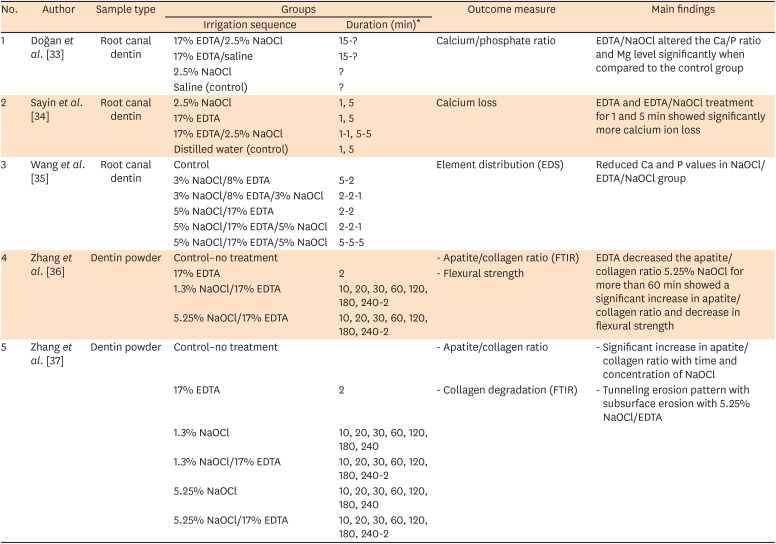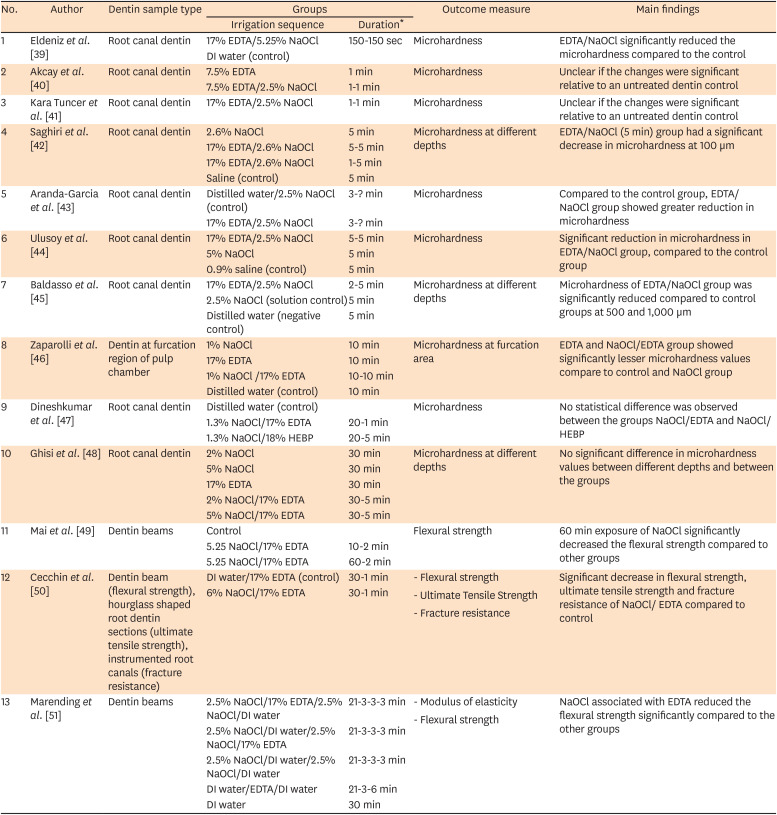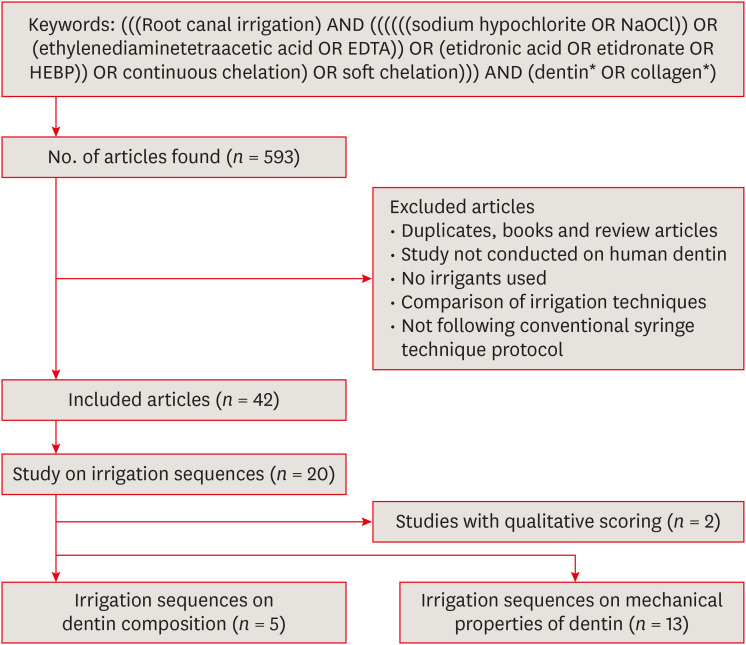1. Marshall GW Jr. Dentin: microstructure and characterization. Quintessence Int. 1993; 24:606–617. PMID:
8272499.
2. Tjäderhane L, Carrilho MR, Breschi L, Tay FR, Pashley DH. Dentin basic structure and composition—An overview. Endod Topics. 2009; 20:3–29.

3. Sloan AJ. Stem cell biology and tissue engineering in dental sciences. Amsterdam: Elsevier/Academic Press;2015. p. Chapter 29.
4. Carda C, Peydró A. Ultrastructural patterns of human dentinal tubules, odontoblasts processes and nerve fibres. Tissue Cell. 2006; 38:141–150. PMID:
16546231.

5. Nissan R, Segal H, Pashley D, Stevens R, Trowbridge H. Ability of bacterial endotoxin to diffuse through human dentin. J Endod. 1995; 21:62–64. PMID:
7714438.

6. Love RM. Regional variation in root dentinal tubule infection by
Streptococcus gordonii
. J Endod. 1996; 22:290–293. PMID:
8934987.
7. Wong DT, Cheung GS. Extension of bactericidal effect of sodium hypochlorite into dentinal tubules. J Endod. 2014; 40:825–829. PMID:
24862710.

8. Berutti E, Marini R, Angeretti A. Penetration ability of different irrigants into dentinal tubules. J Endod. 1997; 23:725–727. PMID:
9487845.

9. Ghorbanzadeh A, Aminsobhani M, Sohrabi K, Chiniforush N, Ghafari S, Shamshiri AR, Noroozi N. Penetration depth of sodium hypochlorite in dentinal tubules after conventional irrigation, passive ultrasonic agitation and Nd: YAG laser activated irrigation. J Lasers Med Sci. 2016; 7:105–111. PMID:
27330706.
10. Sulkala M, Tervahartiala T, Sorsa T, Larmas M, Salo T, Tjäderhane L. Matrix metalloproteinase-8 (MMP-8) is the major collagenase in human dentin. Arch Oral Biol. 2007; 52:121–127. PMID:
17045563.

11. Martin-De Las Heras S, Valenzuela A, Overall CM. The matrix metalloproteinase gelatinase A in human dentine. Arch Oral Biol. 2000; 45:757–765. PMID:
10869489.

12. Marashdeh MQ, Gitalis R, Lévesque C, Finer Y. Endodontic pathogens possess collagenolytic properties that degrade human dentine collagen matrix. Int Endod J. 2019; 52:416–423. PMID:
30246356.

13. Gu LS, Huang XQ, Griffin B, Bergeron BR, Pashley DH, Niu LN, Tay FR. Primum non nocere - The effects of sodium hypochlorite on dentin as used in endodontics. Acta Biomater. 2017; 61:144–156. PMID:
28801267.

14. Siqueira JF Jr, Pérez AR, Marceliano-Alves MF, Provenzano JC, Silva SG, Pires FR, Vieira GC, Rôças IN, Alves FR. What happens to unprepared root canal walls: a correlative analysis using micro-computed tomography and histology/scanning electron microscopy. Int Endod J. 2018; 51:501–508. PMID:
28196289.

15. Peters OA, Arias A, Paqué F. A Micro–computed tomographic assessment of root canal preparation with a novel instrument, TRUShape, in mesial roots of mandibular molars. J Endod. 2015; 41:1545–1550. PMID:
26238528.

16. Haapasalo M, Shen Y, Qian W, Gao Y. Irrigation in endodontics. Dent Clin North Am. 2010; 54:291–312. PMID:
20433979.

17. Krause TA, Liewehr FR, Hahn CL. The antimicrobial effect of MTAD, sodium hypochlorite, doxycycline, and citric acid on Enterococcus faecalis. J Endod. 2007; 33:28–30. PMID:
17185124.

18. Zehnder M. Root canal irrigants. J Endod. 2006; 32:389–398. PMID:
16631834.

19. Sim TP, Knowles JC, Ng YL, Shelton J, Gulabivala K. Effect of sodium hypochlorite on mechanical properties of dentine and tooth surface strain. Int Endod J. 2001; 34:120–132. PMID:
11307260.

20. Slutzky-Goldberg I, Maree M, Liberman R, Heling I. Effect of sodium hypochlorite on dentin microhardness. J Endod. 2004; 30:880–882. PMID:
15564869.
21. Uzunoglu E, Aktemur S, Uyanik MO, Durmaz V, Nagas E. Effect of ethylenediaminetetraacetic acid on root fracture with respect to concentration at different time exposures. J Endod. 2012; 38:1110–1113. PMID:
22794216.

22. Gu XH, Mao CY, Kern M. Effect of different irrigation on smear layer removal after post space preparation. J Endod. 2009; 35:583–586. PMID:
19345810.

23. Calt S, Serper A. Time-dependent effects of EDTA on dentin structures. J Endod. 2002; 28:17–19. PMID:
11806642.

24. Grawehr M, Sener B, Waltimo T, Zehnder M. Interactions of ethylenediamine tetraacetic acid with sodium hypochlorite in aqueous solutions. Int Endod J. 2003; 36:411–417. PMID:
12801288.

25. Prado M, Gusman H, Gomes BP, Simão RA. Scanning electron microscopic investigation of the effectiveness of phosphoric acid in smear layer removal when compared with EDTA and citric acid. J Endod. 2011; 37:255–258. PMID:
21238813.

26. Paqué F, Boessler C, Zehnder M. Accumulated hard tissue debris levels in mesial roots of mandibular molars after sequential irrigation steps. Int Endod J. 2011; 44:148–153. PMID:
21083577.

27. Lottanti S, Gautschi H, Sener B, Zehnder M. Effects of ethylenediaminetetraacetic, etidronic and peracetic acid irrigation on human root dentine and the smear layer. Int Endod J. 2009; 42:335–343. PMID:
19220516.

28. Ulusoy Öİ, Zeyrek S, Çelik B. Evaluation of smear layer removal and marginal adaptation of root canal sealer after final irrigation using ethylenediaminetetraacetic, peracetic, and etidronic acids with different concentrations. Microsc Res Tech. 2017; 80:687–692. PMID:
28190294.

29. Ordinola-Zapata R, Bramante CM, Cavenago B, Graeff MS, Gomes de Moraes I, Marciano M, Duarte MA. Antimicrobial effect of endodontic solutions used as final irrigants on a dentine biofilm model. Int Endod J. 2012; 45:162–168. PMID:
21985189.

30. Arias-Moliz MT, Ordinola-Zapata R, Baca P, Ruiz-Linares M, García García E, Hungaro Duarte MA, Monteiro Bramante C, Ferrer-Luque CM. Antimicrobial activity of chlorhexidine, peracetic acid and sodium hypochlorite/etidronate irrigant solutions against
Enterococcus faecalis biofilms. Int Endod J. 2015; 48:1188–1193. PMID:
25515403.
31. Neelakantan P, Sharma S, Shemesh H, Wesselink PR. Influence of irrigation sequence on the adhesion of root canal sealers to dentin: a fourier transform infrared spectroscopy and push-out bond strength analysis. J Endod. 2015; 41:1108–1111. PMID:
26008114.

32. Dotto L, Sarkis Onofre R, Bacchi A, Rocha Pereira GK. Effect of root canal irrigants on the mechanical properties of endodontically treated teeth: a scoping review. J Endod. 2020; 46:596–604.e3. PMID:
32147184.

33. Doğan H, Qalt S. Effects of chelating agents and sodium hypochlorite on mineral content of root dentin. J Endod. 2001; 27:578–580. PMID:
11556562.
34. Sayin TC, Serper A, Cehreli ZC, Kalayci S. Calcium loss from root canal dentin following EDTA, EGTA, EDTAC, and tetracycline-HCl treatment with or without subsequent NaOCl irrigation. J Endod. 2007; 33:581–584. PMID:
17437877.

35. Wang Z, Maezono H, Shen Y, Haapasalo M. Evaluation of root canal dentin erosion after different irrigation methods using energy-dispersive x-ray spectroscopy. J Endod. 2016; 42:1834–1839. PMID:
27769680.

36. Zhang K, Kim YK, Cadenaro M, Bryan TE, Sidow SJ, Loushine RJ, Ling JQ, Pashley DH, Tay FR. Effects of different exposure times and concentrations of sodium hypochlorite/ethylenediaminetetraacetic acid on the structural integrity of mineralized dentin. J Endod. 2010; 36:105–109. PMID:
20003945.

37. Zhang K, Tay FR, Kim YK, Mitchell JK, Kim JR, Carrilho M, Pashley DH, Ling JQ. The effect of initial irrigation with two different sodium hypochlorite concentrations on the erosion of instrumented radicular dentin. Dent Mater. 2010; 26:514–523. PMID:
20181387.

38. Baldasso FE, Cardoso LR, Silva VD, Morgental RD, Kopper PM. Evaluation of the effect of four final irrigation protocols on root canal dentin components by polarized light microscopy and scanning electron microscopy. Microsc Res Tech. 2017; 80:1337–1343. PMID:
28925588.

39. Eldeniz AU, Erdemir A, Belli S. Effect of EDTA and citric acid solutions on the microhardness and the roughness of human root canal dentin. J Endod. 2005; 31:107–110. PMID:
15671820.

40. Akcay I, Erdilek N, Sen BH. The efficacy of an experimental single solution versus alternate use of multiple irrigants on root dentin microhardness. J Clin Exp Dent. 2013; 5:e83–e88. PMID:
24455062.

41. Kara Tuncer A, Tuncer S, Siso SH. Effect of QMix irrigant on the microhardness of root canal dentine. Aust Dent J. 2015; 60:163–168. PMID:
25329355.

42. Saghiri MA, Delvarani A, Mehrvarzfar P, Malganji G, Lotfi M, Dadresanfar B, Saghiri AM, Dadvand S. A study of the relation between erosion and microhardness of root canal dentin. Oral Surg Oral Med Oral Pathol Oral Radiol Endod. 2009; 108:e29–e34.

43. Aranda-Garcia AJ, Kuga MC, Chavéz-Andrade GM, Kalatzis-Sousa NG, Hungaro Duarte MA, Faria G, Reis Só MV, Faria NB Jr. Effect of final irrigation protocols on microhardness and erosion of root canal dentin. Microsc Res Tech. 2013; 76:1079–1083. PMID:
23897860.

44. Ulusoy Öİ, Görgül G. Effects of different irrigation solutions on root dentine microhardness, smear layer removal and erosion. Aust Endod J. 2013; 39:66–72. PMID:
23890262.

45. Baldasso FE, Roleto L, da Silva VD, Morgental RD, Kopper PM. Effect of final irrigation protocols on microhardness reduction and erosion of root canal dentin. Br Oral Res. 2017; 31:e40.

46. Zaparolli D, Saquy PC, Cruz-Filho AM. Effect of sodium hypochlorite and EDTA irrigation, individually and in alternation, on dentin microhardness at the furcation area of mandibular molars. Braz Dent J. 2012; 23:654–658. PMID:
23338256.

47. Dineshkumar MK, Vinothkumar TS, Arathi G, Shanthisree P, Kandaswamy D. Effect of ethylene diamine tetra-acetic acid, MTAD™, and HEBP as a final rinse on the microhardness of root dentin. J Conserv Dent. 2012; 15:170–173. PMID:
22557818.
48. Ghisi AC, Kopper PM, Baldasso FE, Stürmer CP, Rossi-Fedele G, Steier L, Figueiredo JA, Morgental RD, Vier-Pelisser FV. Effect of super-oxidized water, sodium hypochlorite and EDTA on dentin microhardness. Braz Dent J. 2014; 25:420–424. PMID:
25517778.

49. Mai S, Kim YK, Arola DD, Gu LS, Kim JR, Pashley DH, Tay FR. Differential aggressiveness of ethylenediamine tetraacetic acid in causing canal wall erosion in the presence of sodium hypochlorite. J Dent. 2010; 38:201–206. PMID:
19853002.

50. Cecchin D, Soares Giaretta V, Granella Cadorin B, Albino Souza M, Vidal CM, Paula Farina A. Effect of synthetic and natural-derived novel endodontic irrigant solutions on mechanical properties of human dentin. J Mater Sci Mater Med. 2017; 28:141. PMID:
28819809.

51. Marending M, Paqué F, Fischer J, Zehnder M. Impact of irrigant sequence on mechanical properties of human root dentin. J Endod. 2007; 33:1325–1328. PMID:
17963956.

52. Qian W, Shen Y, Haapasalo M. Quantitative analysis of the effect of irrigant solution sequences on dentin erosion. J Endod. 2011; 37:1437–1441. PMID:
21924198.

53. Estrela C, Estrela CR, Barbin EL, Spanó JC, Marchesan MA, Pécora JD. Mechanism of action of sodium hypochlorite. Braz Dent J. 2002; 13:113–117. PMID:
12238801.

54. Gelse K, Pöschl E, Aigner T. Collagens--structure, function, and biosynthesis. Adv Drug Deliv Rev. 2003; 55:1531–1546. PMID:
14623400.

55. Oyarzún A, Cordero AM, Whittle M. Immunohistochemical evaluation of the effects of sodium hypochlorite on dentin collagen and glycosaminoglycans. J Endod. 2002; 28:152–156. PMID:
12017169.
56. Mohammadi Z. Sodium hypochlorite in endodontics: an update review. Int Dent J. 2008; 58:329–341. PMID:
19145794.

57. Hülsmann M. Effects of mechanical instrumentation and chemical irrigation on the root canal dentin and surrounding tissues. Endod Topics. 2013; 29:55–86.

58. Pascon FM, Kantovitz KR, Sacramento PA, Nobre-dos-Santos M, Puppin-Rontani RM. Effect of sodium hypochlorite on dentine mechanical properties. A review. J Dent. 2009; 37:903–908. PMID:
19665276.

59. Violich DR, Chandler NP. The smear layer in endodontics - a review. Int Endod J. 2010; 43:2–15. PMID:
20002799.

60. Correr GM, Alonso RC, Grando MF, Borges AF, Puppin-Rontani RM. Effect of sodium hypochlorite on primary dentin--a scanning electron microscopy (SEM) evaluation. J Dent. 2006; 34:454–459. PMID:
16310920.

61. Zou L, Shen Y, Li W, Haapasalo M. Penetration of sodium hypochlorite into dentin. J Endod. 2010; 36:793–796. PMID:
20416421.

62. Di Renzo M, Ellis TH, Sacher E, Stangel I. A photoacoustic FTIRS study of the chemical modifications of human dentin surfaces: II. Deproteination. Biomaterials. 2001; 22:793–797. PMID:
11246947.






 PDF
PDF Citation
Citation Print
Print




 XML Download
XML Download